Change Management Report: Australia Post, Organizational Analysis
VerifiedAdded on 2020/04/07
|14
|4032
|485
Report
AI Summary
This report provides a detailed analysis of change management within Australia Post. It begins by defining organizational change and its importance, followed by an overview of Australia Post's operations and the need for change. The report examines the specific changes implemented, such as improvements in services, adoption of new technologies, and employee training and development, and links these changes to the core definitions of change management. A SWOT analysis is conducted to evaluate the company's strengths, weaknesses, opportunities, and threats, highlighting the drivers and benefits of change. The role of change agents, both internal and external, is discussed, along with problem-centric and dialogic approaches to change management. The report concludes by emphasizing the importance of a structured approach to managing change and its impact on achieving organizational goals.
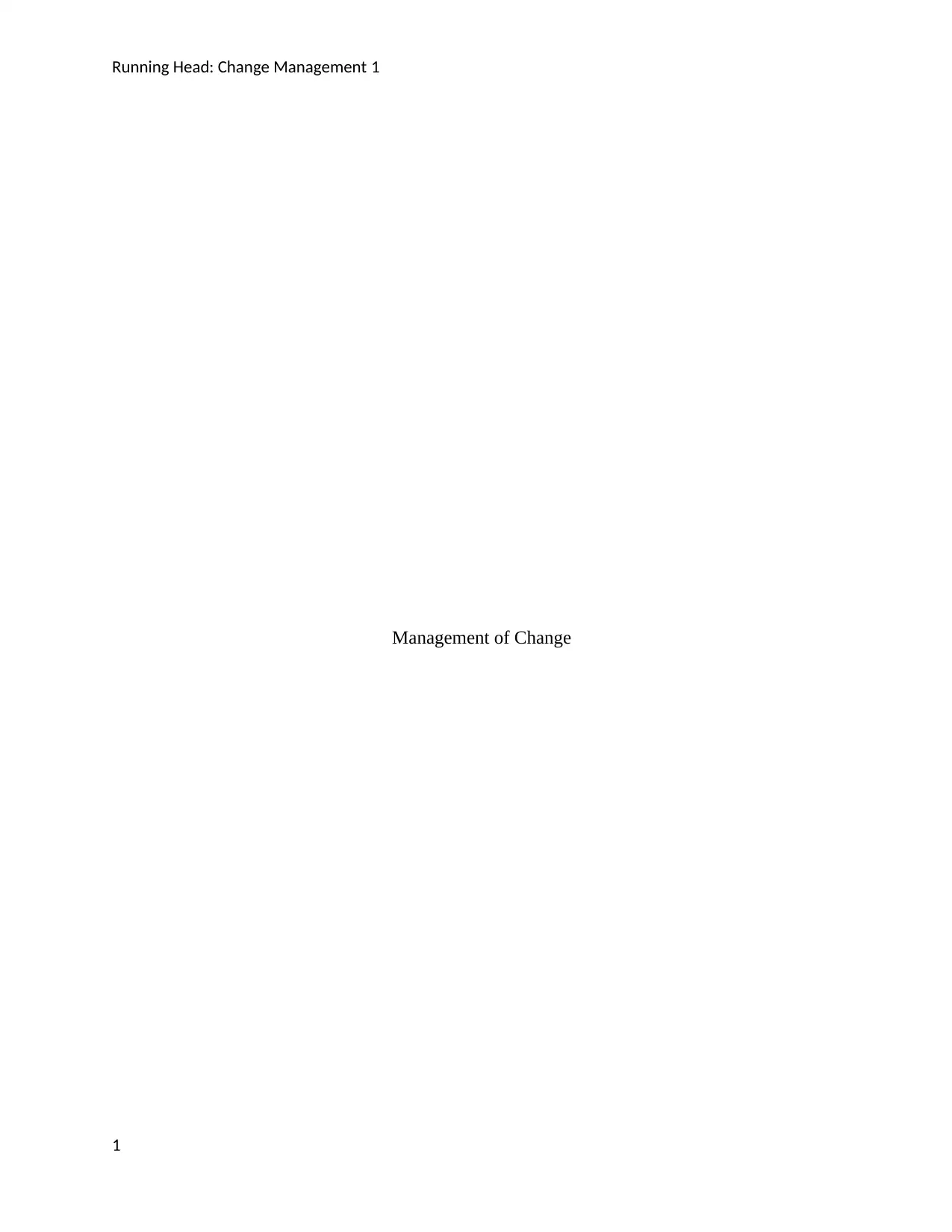
Running Head: Change Management 1
Management of Change
1
Management of Change
1
Paraphrase This Document
Need a fresh take? Get an instant paraphrase of this document with our AI Paraphraser
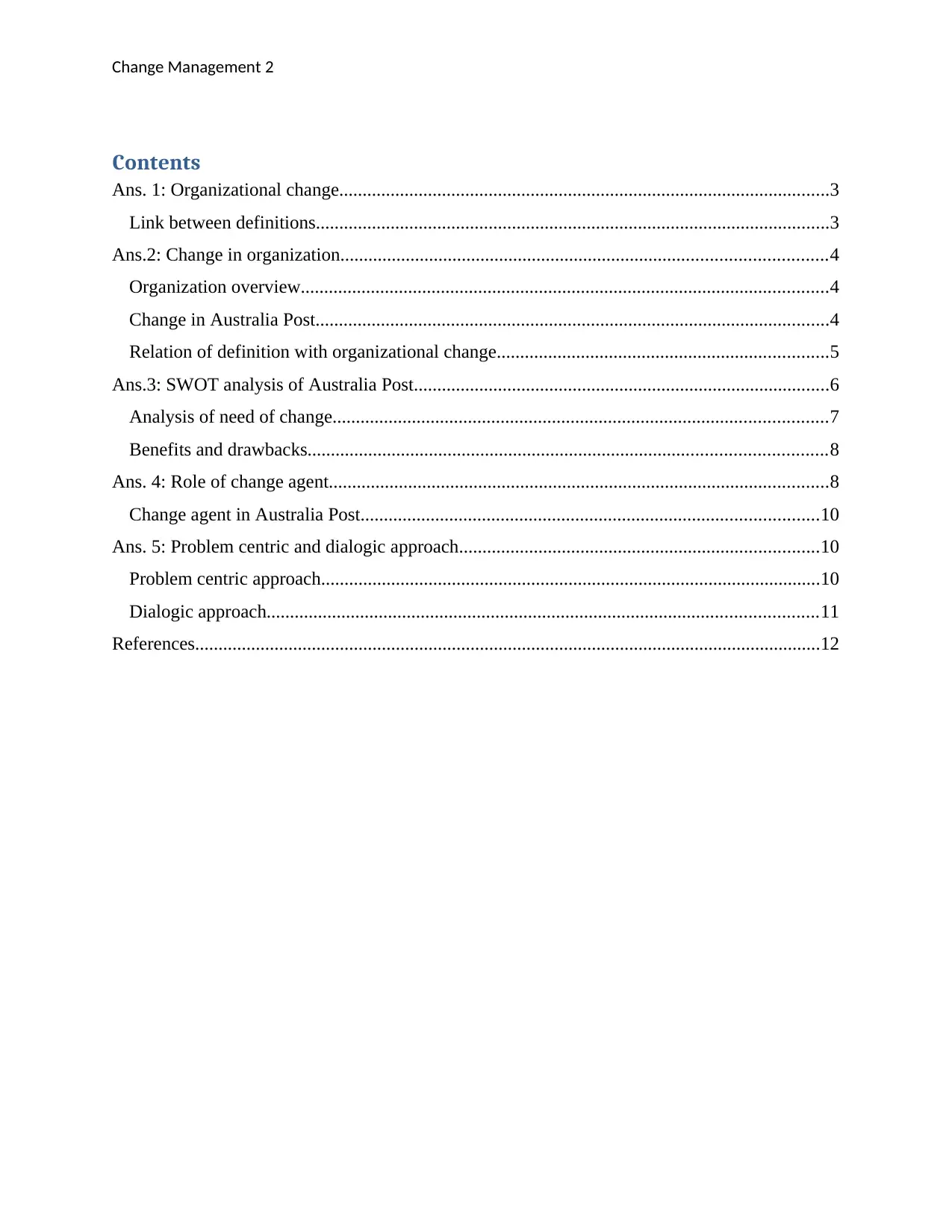
Change Management 2
Contents
Ans. 1: Organizational change.........................................................................................................3
Link between definitions..............................................................................................................3
Ans.2: Change in organization........................................................................................................4
Organization overview.................................................................................................................4
Change in Australia Post..............................................................................................................4
Relation of definition with organizational change.......................................................................5
Ans.3: SWOT analysis of Australia Post.........................................................................................6
Analysis of need of change..........................................................................................................7
Benefits and drawbacks...............................................................................................................8
Ans. 4: Role of change agent...........................................................................................................8
Change agent in Australia Post..................................................................................................10
Ans. 5: Problem centric and dialogic approach.............................................................................10
Problem centric approach...........................................................................................................10
Dialogic approach......................................................................................................................11
References......................................................................................................................................12
Contents
Ans. 1: Organizational change.........................................................................................................3
Link between definitions..............................................................................................................3
Ans.2: Change in organization........................................................................................................4
Organization overview.................................................................................................................4
Change in Australia Post..............................................................................................................4
Relation of definition with organizational change.......................................................................5
Ans.3: SWOT analysis of Australia Post.........................................................................................6
Analysis of need of change..........................................................................................................7
Benefits and drawbacks...............................................................................................................8
Ans. 4: Role of change agent...........................................................................................................8
Change agent in Australia Post..................................................................................................10
Ans. 5: Problem centric and dialogic approach.............................................................................10
Problem centric approach...........................................................................................................10
Dialogic approach......................................................................................................................11
References......................................................................................................................................12
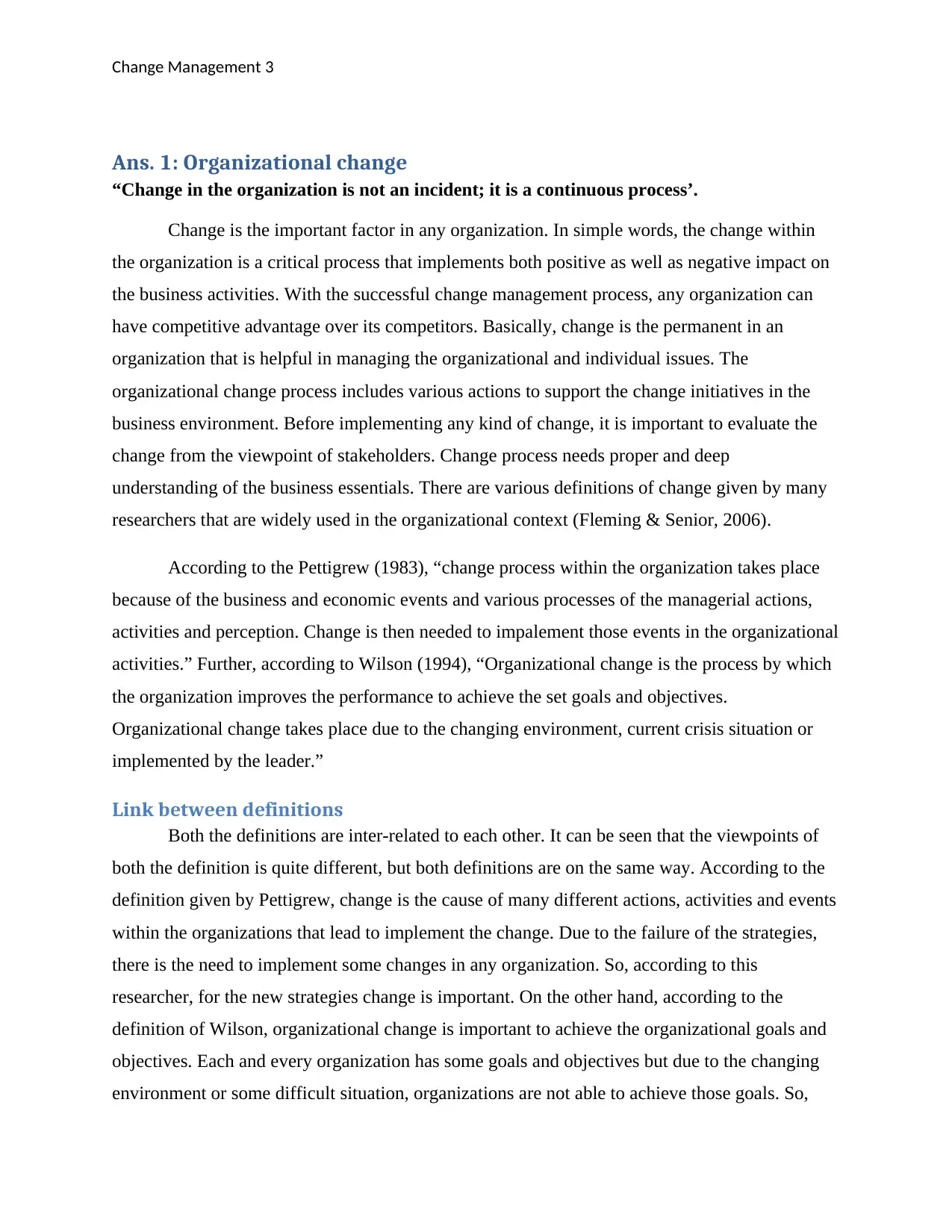
Change Management 3
Ans. 1: Organizational change
“Change in the organization is not an incident; it is a continuous process’.
Change is the important factor in any organization. In simple words, the change within
the organization is a critical process that implements both positive as well as negative impact on
the business activities. With the successful change management process, any organization can
have competitive advantage over its competitors. Basically, change is the permanent in an
organization that is helpful in managing the organizational and individual issues. The
organizational change process includes various actions to support the change initiatives in the
business environment. Before implementing any kind of change, it is important to evaluate the
change from the viewpoint of stakeholders. Change process needs proper and deep
understanding of the business essentials. There are various definitions of change given by many
researchers that are widely used in the organizational context (Fleming & Senior, 2006).
According to the Pettigrew (1983), “change process within the organization takes place
because of the business and economic events and various processes of the managerial actions,
activities and perception. Change is then needed to impalement those events in the organizational
activities.” Further, according to Wilson (1994), “Organizational change is the process by which
the organization improves the performance to achieve the set goals and objectives.
Organizational change takes place due to the changing environment, current crisis situation or
implemented by the leader.”
Link between definitions
Both the definitions are inter-related to each other. It can be seen that the viewpoints of
both the definition is quite different, but both definitions are on the same way. According to the
definition given by Pettigrew, change is the cause of many different actions, activities and events
within the organizations that lead to implement the change. Due to the failure of the strategies,
there is the need to implement some changes in any organization. So, according to this
researcher, for the new strategies change is important. On the other hand, according to the
definition of Wilson, organizational change is important to achieve the organizational goals and
objectives. Each and every organization has some goals and objectives but due to the changing
environment or some difficult situation, organizations are not able to achieve those goals. So,
Ans. 1: Organizational change
“Change in the organization is not an incident; it is a continuous process’.
Change is the important factor in any organization. In simple words, the change within
the organization is a critical process that implements both positive as well as negative impact on
the business activities. With the successful change management process, any organization can
have competitive advantage over its competitors. Basically, change is the permanent in an
organization that is helpful in managing the organizational and individual issues. The
organizational change process includes various actions to support the change initiatives in the
business environment. Before implementing any kind of change, it is important to evaluate the
change from the viewpoint of stakeholders. Change process needs proper and deep
understanding of the business essentials. There are various definitions of change given by many
researchers that are widely used in the organizational context (Fleming & Senior, 2006).
According to the Pettigrew (1983), “change process within the organization takes place
because of the business and economic events and various processes of the managerial actions,
activities and perception. Change is then needed to impalement those events in the organizational
activities.” Further, according to Wilson (1994), “Organizational change is the process by which
the organization improves the performance to achieve the set goals and objectives.
Organizational change takes place due to the changing environment, current crisis situation or
implemented by the leader.”
Link between definitions
Both the definitions are inter-related to each other. It can be seen that the viewpoints of
both the definition is quite different, but both definitions are on the same way. According to the
definition given by Pettigrew, change is the cause of many different actions, activities and events
within the organizations that lead to implement the change. Due to the failure of the strategies,
there is the need to implement some changes in any organization. So, according to this
researcher, for the new strategies change is important. On the other hand, according to the
definition of Wilson, organizational change is important to achieve the organizational goals and
objectives. Each and every organization has some goals and objectives but due to the changing
environment or some difficult situation, organizations are not able to achieve those goals. So,
⊘ This is a preview!⊘
Do you want full access?
Subscribe today to unlock all pages.

Trusted by 1+ million students worldwide
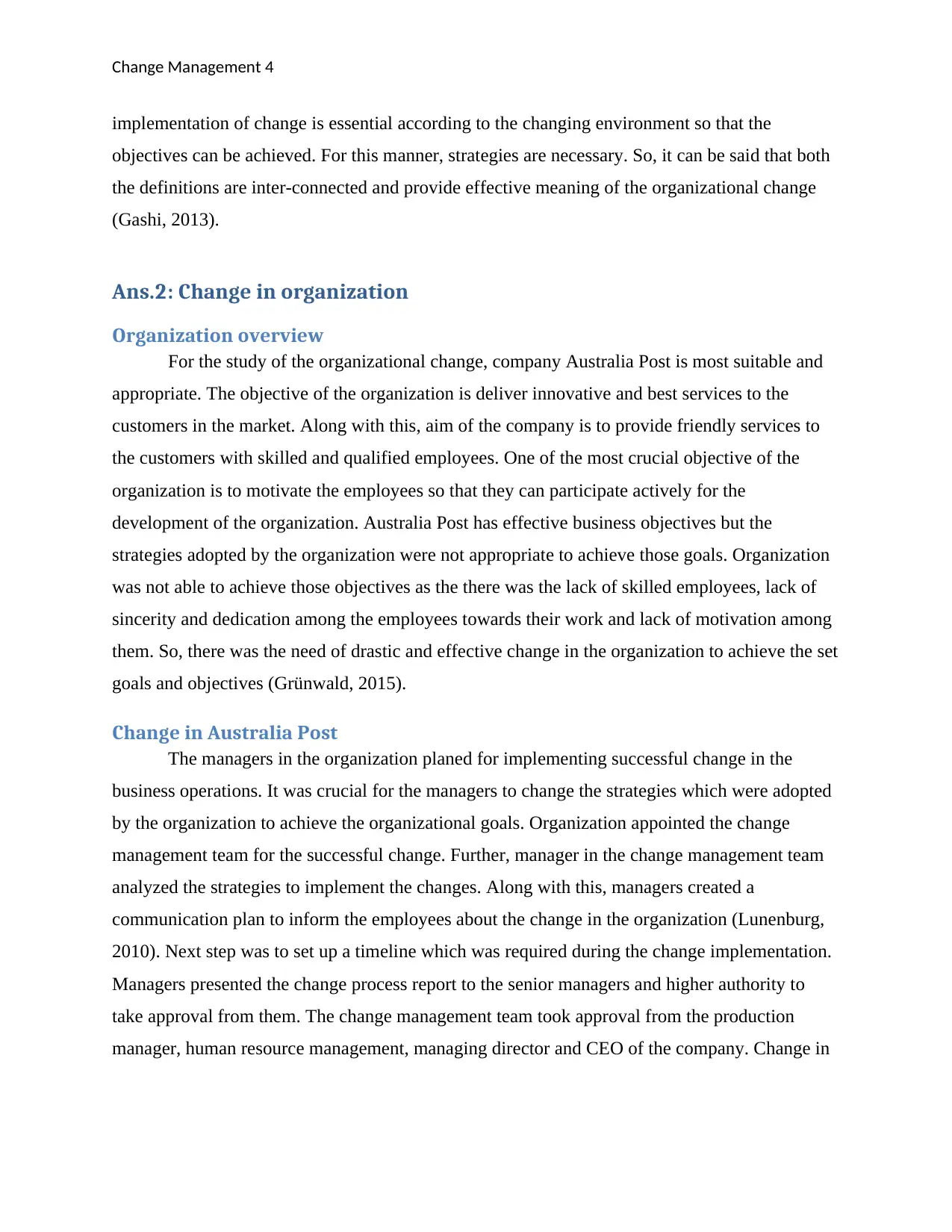
Change Management 4
implementation of change is essential according to the changing environment so that the
objectives can be achieved. For this manner, strategies are necessary. So, it can be said that both
the definitions are inter-connected and provide effective meaning of the organizational change
(Gashi, 2013).
Ans.2: Change in organization
Organization overview
For the study of the organizational change, company Australia Post is most suitable and
appropriate. The objective of the organization is deliver innovative and best services to the
customers in the market. Along with this, aim of the company is to provide friendly services to
the customers with skilled and qualified employees. One of the most crucial objective of the
organization is to motivate the employees so that they can participate actively for the
development of the organization. Australia Post has effective business objectives but the
strategies adopted by the organization were not appropriate to achieve those goals. Organization
was not able to achieve those objectives as the there was the lack of skilled employees, lack of
sincerity and dedication among the employees towards their work and lack of motivation among
them. So, there was the need of drastic and effective change in the organization to achieve the set
goals and objectives (Grünwald, 2015).
Change in Australia Post
The managers in the organization planed for implementing successful change in the
business operations. It was crucial for the managers to change the strategies which were adopted
by the organization to achieve the organizational goals. Organization appointed the change
management team for the successful change. Further, manager in the change management team
analyzed the strategies to implement the changes. Along with this, managers created a
communication plan to inform the employees about the change in the organization (Lunenburg,
2010). Next step was to set up a timeline which was required during the change implementation.
Managers presented the change process report to the senior managers and higher authority to
take approval from them. The change management team took approval from the production
manager, human resource management, managing director and CEO of the company. Change in
implementation of change is essential according to the changing environment so that the
objectives can be achieved. For this manner, strategies are necessary. So, it can be said that both
the definitions are inter-connected and provide effective meaning of the organizational change
(Gashi, 2013).
Ans.2: Change in organization
Organization overview
For the study of the organizational change, company Australia Post is most suitable and
appropriate. The objective of the organization is deliver innovative and best services to the
customers in the market. Along with this, aim of the company is to provide friendly services to
the customers with skilled and qualified employees. One of the most crucial objective of the
organization is to motivate the employees so that they can participate actively for the
development of the organization. Australia Post has effective business objectives but the
strategies adopted by the organization were not appropriate to achieve those goals. Organization
was not able to achieve those objectives as the there was the lack of skilled employees, lack of
sincerity and dedication among the employees towards their work and lack of motivation among
them. So, there was the need of drastic and effective change in the organization to achieve the set
goals and objectives (Grünwald, 2015).
Change in Australia Post
The managers in the organization planed for implementing successful change in the
business operations. It was crucial for the managers to change the strategies which were adopted
by the organization to achieve the organizational goals. Organization appointed the change
management team for the successful change. Further, manager in the change management team
analyzed the strategies to implement the changes. Along with this, managers created a
communication plan to inform the employees about the change in the organization (Lunenburg,
2010). Next step was to set up a timeline which was required during the change implementation.
Managers presented the change process report to the senior managers and higher authority to
take approval from them. The change management team took approval from the production
manager, human resource management, managing director and CEO of the company. Change in
Paraphrase This Document
Need a fresh take? Get an instant paraphrase of this document with our AI Paraphraser
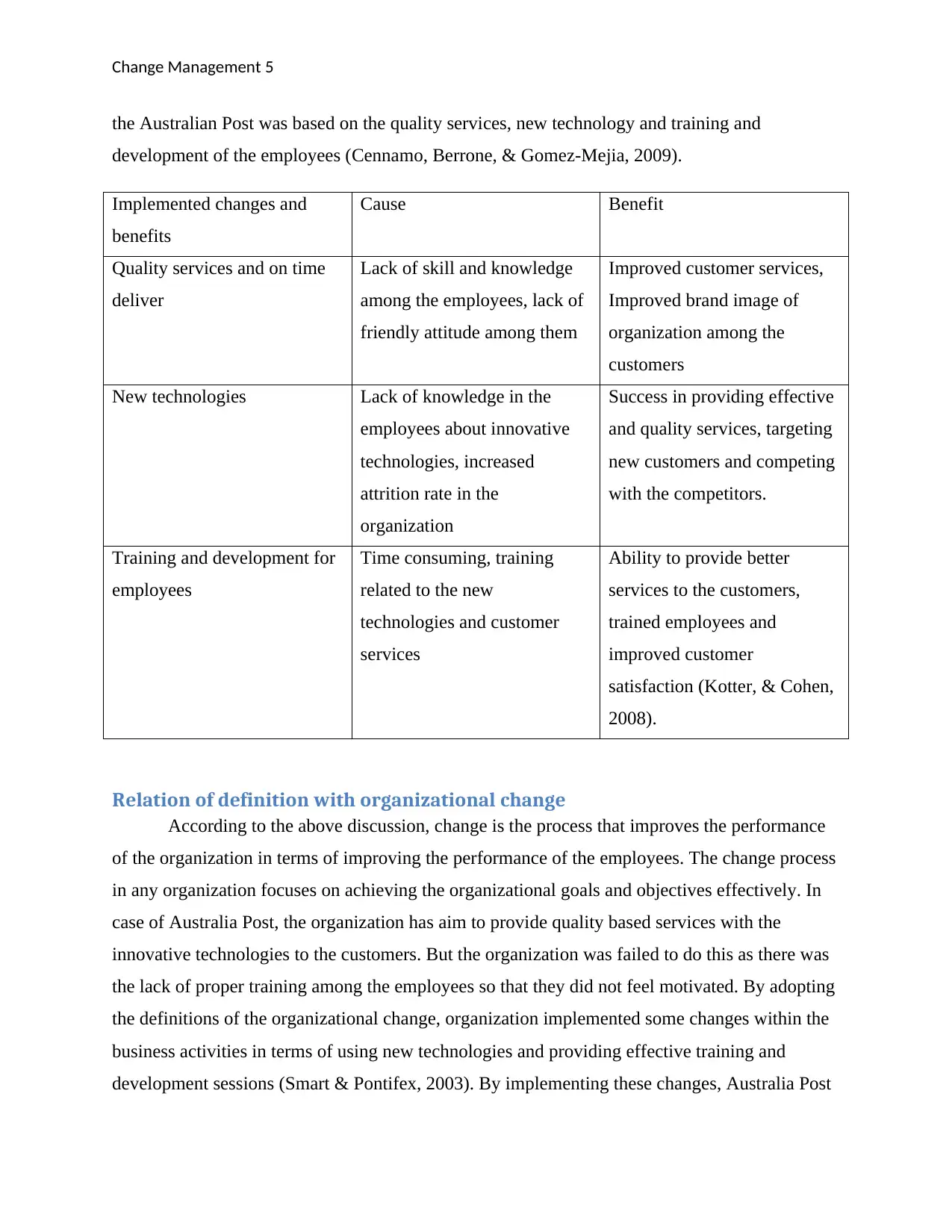
Change Management 5
the Australian Post was based on the quality services, new technology and training and
development of the employees (Cennamo, Berrone, & Gomez-Mejia, 2009).
Implemented changes and
benefits
Cause Benefit
Quality services and on time
deliver
Lack of skill and knowledge
among the employees, lack of
friendly attitude among them
Improved customer services,
Improved brand image of
organization among the
customers
New technologies Lack of knowledge in the
employees about innovative
technologies, increased
attrition rate in the
organization
Success in providing effective
and quality services, targeting
new customers and competing
with the competitors.
Training and development for
employees
Time consuming, training
related to the new
technologies and customer
services
Ability to provide better
services to the customers,
trained employees and
improved customer
satisfaction (Kotter, & Cohen,
2008).
Relation of definition with organizational change
According to the above discussion, change is the process that improves the performance
of the organization in terms of improving the performance of the employees. The change process
in any organization focuses on achieving the organizational goals and objectives effectively. In
case of Australia Post, the organization has aim to provide quality based services with the
innovative technologies to the customers. But the organization was failed to do this as there was
the lack of proper training among the employees so that they did not feel motivated. By adopting
the definitions of the organizational change, organization implemented some changes within the
business activities in terms of using new technologies and providing effective training and
development sessions (Smart & Pontifex, 2003). By implementing these changes, Australia Post
the Australian Post was based on the quality services, new technology and training and
development of the employees (Cennamo, Berrone, & Gomez-Mejia, 2009).
Implemented changes and
benefits
Cause Benefit
Quality services and on time
deliver
Lack of skill and knowledge
among the employees, lack of
friendly attitude among them
Improved customer services,
Improved brand image of
organization among the
customers
New technologies Lack of knowledge in the
employees about innovative
technologies, increased
attrition rate in the
organization
Success in providing effective
and quality services, targeting
new customers and competing
with the competitors.
Training and development for
employees
Time consuming, training
related to the new
technologies and customer
services
Ability to provide better
services to the customers,
trained employees and
improved customer
satisfaction (Kotter, & Cohen,
2008).
Relation of definition with organizational change
According to the above discussion, change is the process that improves the performance
of the organization in terms of improving the performance of the employees. The change process
in any organization focuses on achieving the organizational goals and objectives effectively. In
case of Australia Post, the organization has aim to provide quality based services with the
innovative technologies to the customers. But the organization was failed to do this as there was
the lack of proper training among the employees so that they did not feel motivated. By adopting
the definitions of the organizational change, organization implemented some changes within the
business activities in terms of using new technologies and providing effective training and
development sessions (Smart & Pontifex, 2003). By implementing these changes, Australia Post
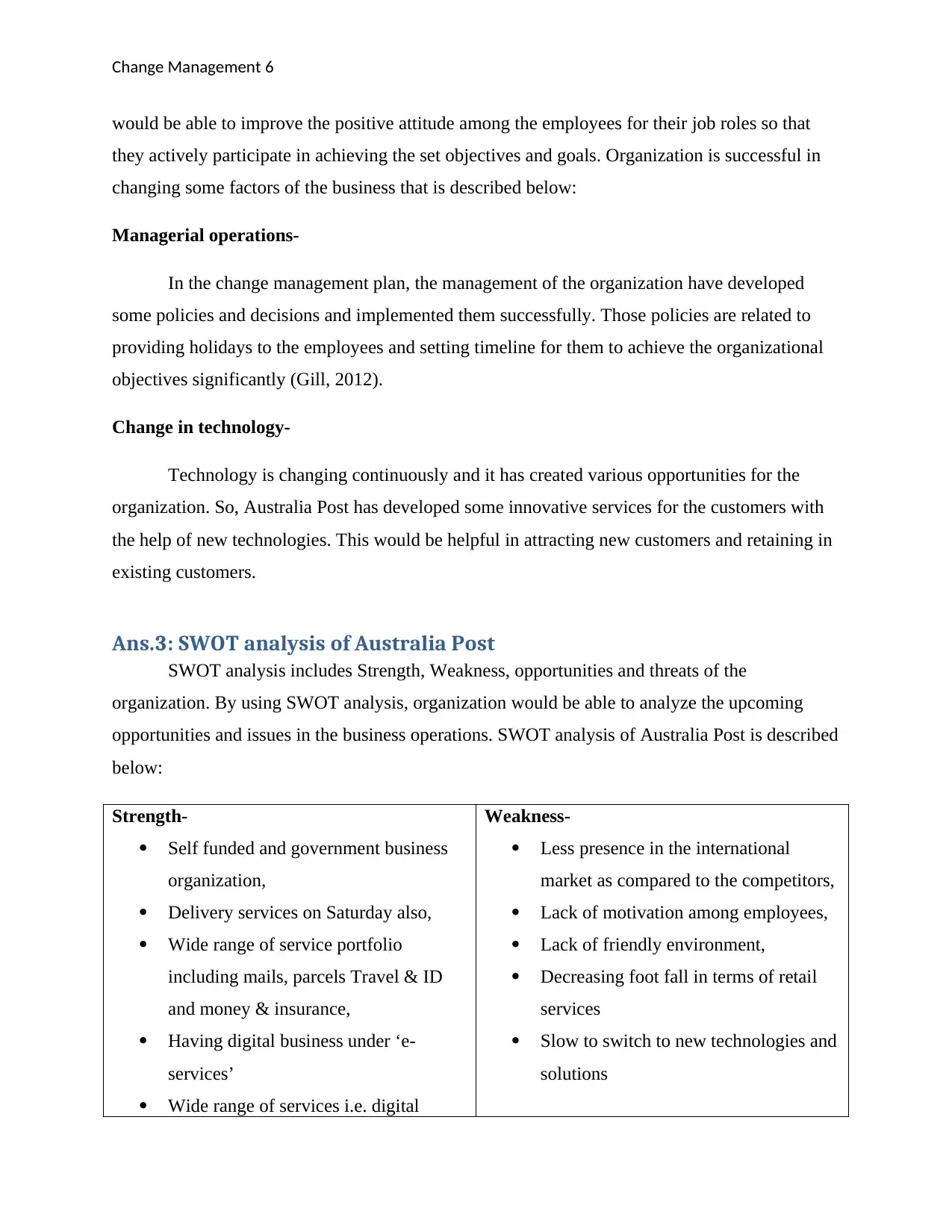
Change Management 6
would be able to improve the positive attitude among the employees for their job roles so that
they actively participate in achieving the set objectives and goals. Organization is successful in
changing some factors of the business that is described below:
Managerial operations-
In the change management plan, the management of the organization have developed
some policies and decisions and implemented them successfully. Those policies are related to
providing holidays to the employees and setting timeline for them to achieve the organizational
objectives significantly (Gill, 2012).
Change in technology-
Technology is changing continuously and it has created various opportunities for the
organization. So, Australia Post has developed some innovative services for the customers with
the help of new technologies. This would be helpful in attracting new customers and retaining in
existing customers.
Ans.3: SWOT analysis of Australia Post
SWOT analysis includes Strength, Weakness, opportunities and threats of the
organization. By using SWOT analysis, organization would be able to analyze the upcoming
opportunities and issues in the business operations. SWOT analysis of Australia Post is described
below:
Strength-
Self funded and government business
organization,
Delivery services on Saturday also,
Wide range of service portfolio
including mails, parcels Travel & ID
and money & insurance,
Having digital business under ‘e-
services’
Wide range of services i.e. digital
Weakness-
Less presence in the international
market as compared to the competitors,
Lack of motivation among employees,
Lack of friendly environment,
Decreasing foot fall in terms of retail
services
Slow to switch to new technologies and
solutions
would be able to improve the positive attitude among the employees for their job roles so that
they actively participate in achieving the set objectives and goals. Organization is successful in
changing some factors of the business that is described below:
Managerial operations-
In the change management plan, the management of the organization have developed
some policies and decisions and implemented them successfully. Those policies are related to
providing holidays to the employees and setting timeline for them to achieve the organizational
objectives significantly (Gill, 2012).
Change in technology-
Technology is changing continuously and it has created various opportunities for the
organization. So, Australia Post has developed some innovative services for the customers with
the help of new technologies. This would be helpful in attracting new customers and retaining in
existing customers.
Ans.3: SWOT analysis of Australia Post
SWOT analysis includes Strength, Weakness, opportunities and threats of the
organization. By using SWOT analysis, organization would be able to analyze the upcoming
opportunities and issues in the business operations. SWOT analysis of Australia Post is described
below:
Strength-
Self funded and government business
organization,
Delivery services on Saturday also,
Wide range of service portfolio
including mails, parcels Travel & ID
and money & insurance,
Having digital business under ‘e-
services’
Wide range of services i.e. digital
Weakness-
Less presence in the international
market as compared to the competitors,
Lack of motivation among employees,
Lack of friendly environment,
Decreasing foot fall in terms of retail
services
Slow to switch to new technologies and
solutions
⊘ This is a preview!⊘
Do you want full access?
Subscribe today to unlock all pages.

Trusted by 1+ million students worldwide
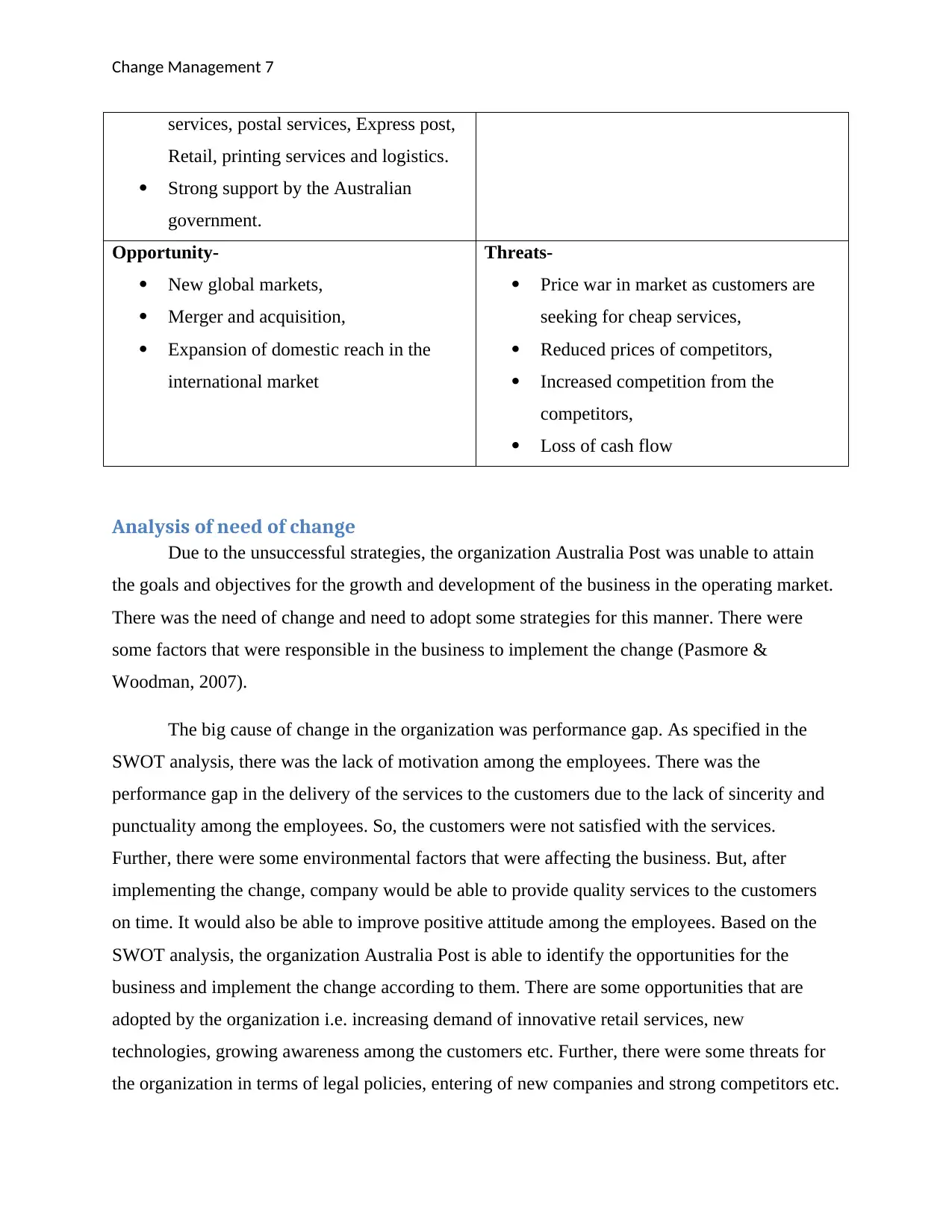
Change Management 7
services, postal services, Express post,
Retail, printing services and logistics.
Strong support by the Australian
government.
Opportunity-
New global markets,
Merger and acquisition,
Expansion of domestic reach in the
international market
Threats-
Price war in market as customers are
seeking for cheap services,
Reduced prices of competitors,
Increased competition from the
competitors,
Loss of cash flow
Analysis of need of change
Due to the unsuccessful strategies, the organization Australia Post was unable to attain
the goals and objectives for the growth and development of the business in the operating market.
There was the need of change and need to adopt some strategies for this manner. There were
some factors that were responsible in the business to implement the change (Pasmore &
Woodman, 2007).
The big cause of change in the organization was performance gap. As specified in the
SWOT analysis, there was the lack of motivation among the employees. There was the
performance gap in the delivery of the services to the customers due to the lack of sincerity and
punctuality among the employees. So, the customers were not satisfied with the services.
Further, there were some environmental factors that were affecting the business. But, after
implementing the change, company would be able to provide quality services to the customers
on time. It would also be able to improve positive attitude among the employees. Based on the
SWOT analysis, the organization Australia Post is able to identify the opportunities for the
business and implement the change according to them. There are some opportunities that are
adopted by the organization i.e. increasing demand of innovative retail services, new
technologies, growing awareness among the customers etc. Further, there were some threats for
the organization in terms of legal policies, entering of new companies and strong competitors etc.
services, postal services, Express post,
Retail, printing services and logistics.
Strong support by the Australian
government.
Opportunity-
New global markets,
Merger and acquisition,
Expansion of domestic reach in the
international market
Threats-
Price war in market as customers are
seeking for cheap services,
Reduced prices of competitors,
Increased competition from the
competitors,
Loss of cash flow
Analysis of need of change
Due to the unsuccessful strategies, the organization Australia Post was unable to attain
the goals and objectives for the growth and development of the business in the operating market.
There was the need of change and need to adopt some strategies for this manner. There were
some factors that were responsible in the business to implement the change (Pasmore &
Woodman, 2007).
The big cause of change in the organization was performance gap. As specified in the
SWOT analysis, there was the lack of motivation among the employees. There was the
performance gap in the delivery of the services to the customers due to the lack of sincerity and
punctuality among the employees. So, the customers were not satisfied with the services.
Further, there were some environmental factors that were affecting the business. But, after
implementing the change, company would be able to provide quality services to the customers
on time. It would also be able to improve positive attitude among the employees. Based on the
SWOT analysis, the organization Australia Post is able to identify the opportunities for the
business and implement the change according to them. There are some opportunities that are
adopted by the organization i.e. increasing demand of innovative retail services, new
technologies, growing awareness among the customers etc. Further, there were some threats for
the organization in terms of legal policies, entering of new companies and strong competitors etc.
Paraphrase This Document
Need a fresh take? Get an instant paraphrase of this document with our AI Paraphraser
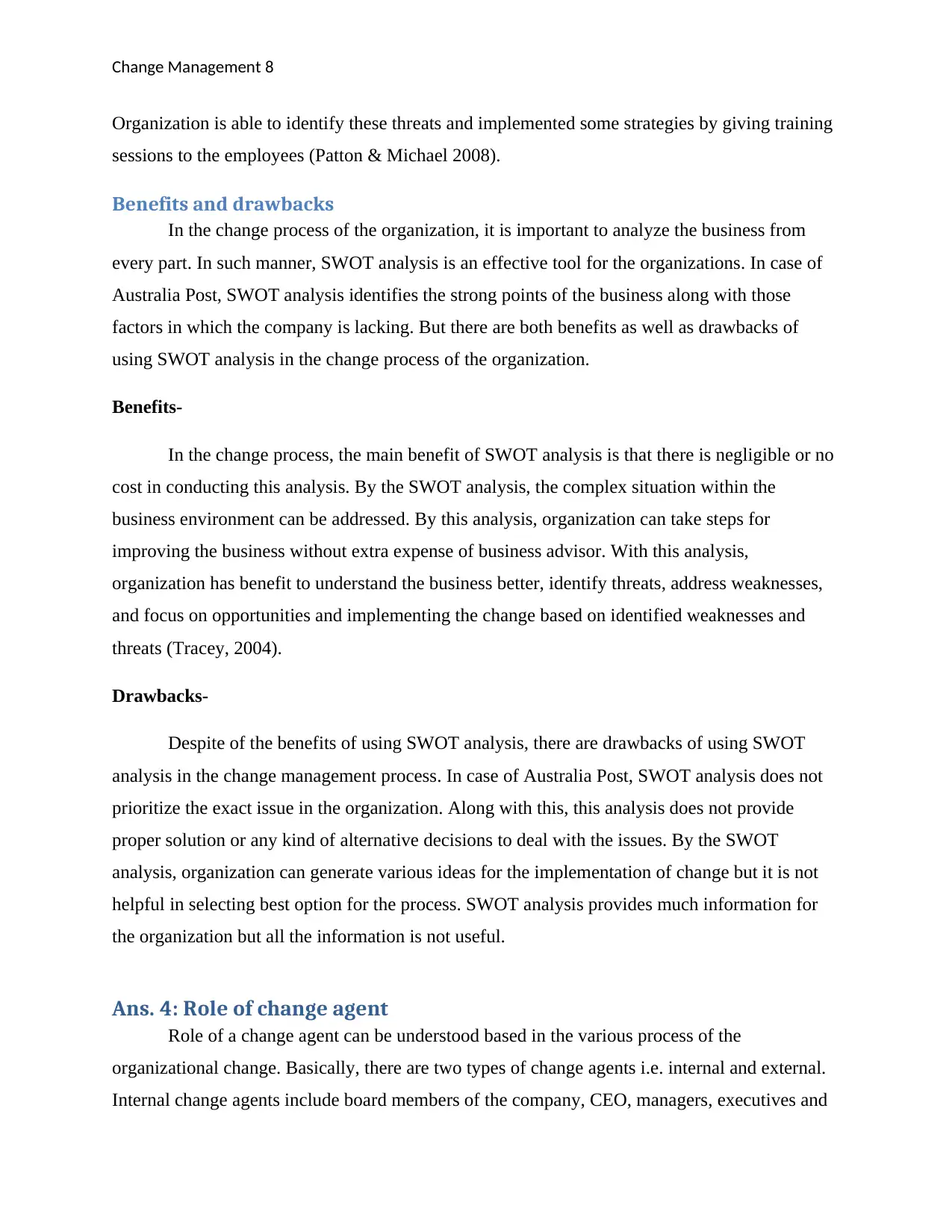
Change Management 8
Organization is able to identify these threats and implemented some strategies by giving training
sessions to the employees (Patton & Michael 2008).
Benefits and drawbacks
In the change process of the organization, it is important to analyze the business from
every part. In such manner, SWOT analysis is an effective tool for the organizations. In case of
Australia Post, SWOT analysis identifies the strong points of the business along with those
factors in which the company is lacking. But there are both benefits as well as drawbacks of
using SWOT analysis in the change process of the organization.
Benefits-
In the change process, the main benefit of SWOT analysis is that there is negligible or no
cost in conducting this analysis. By the SWOT analysis, the complex situation within the
business environment can be addressed. By this analysis, organization can take steps for
improving the business without extra expense of business advisor. With this analysis,
organization has benefit to understand the business better, identify threats, address weaknesses,
and focus on opportunities and implementing the change based on identified weaknesses and
threats (Tracey, 2004).
Drawbacks-
Despite of the benefits of using SWOT analysis, there are drawbacks of using SWOT
analysis in the change management process. In case of Australia Post, SWOT analysis does not
prioritize the exact issue in the organization. Along with this, this analysis does not provide
proper solution or any kind of alternative decisions to deal with the issues. By the SWOT
analysis, organization can generate various ideas for the implementation of change but it is not
helpful in selecting best option for the process. SWOT analysis provides much information for
the organization but all the information is not useful.
Ans. 4: Role of change agent
Role of a change agent can be understood based in the various process of the
organizational change. Basically, there are two types of change agents i.e. internal and external.
Internal change agents include board members of the company, CEO, managers, executives and
Organization is able to identify these threats and implemented some strategies by giving training
sessions to the employees (Patton & Michael 2008).
Benefits and drawbacks
In the change process of the organization, it is important to analyze the business from
every part. In such manner, SWOT analysis is an effective tool for the organizations. In case of
Australia Post, SWOT analysis identifies the strong points of the business along with those
factors in which the company is lacking. But there are both benefits as well as drawbacks of
using SWOT analysis in the change process of the organization.
Benefits-
In the change process, the main benefit of SWOT analysis is that there is negligible or no
cost in conducting this analysis. By the SWOT analysis, the complex situation within the
business environment can be addressed. By this analysis, organization can take steps for
improving the business without extra expense of business advisor. With this analysis,
organization has benefit to understand the business better, identify threats, address weaknesses,
and focus on opportunities and implementing the change based on identified weaknesses and
threats (Tracey, 2004).
Drawbacks-
Despite of the benefits of using SWOT analysis, there are drawbacks of using SWOT
analysis in the change management process. In case of Australia Post, SWOT analysis does not
prioritize the exact issue in the organization. Along with this, this analysis does not provide
proper solution or any kind of alternative decisions to deal with the issues. By the SWOT
analysis, organization can generate various ideas for the implementation of change but it is not
helpful in selecting best option for the process. SWOT analysis provides much information for
the organization but all the information is not useful.
Ans. 4: Role of change agent
Role of a change agent can be understood based in the various process of the
organizational change. Basically, there are two types of change agents i.e. internal and external.
Internal change agents include board members of the company, CEO, managers, executives and
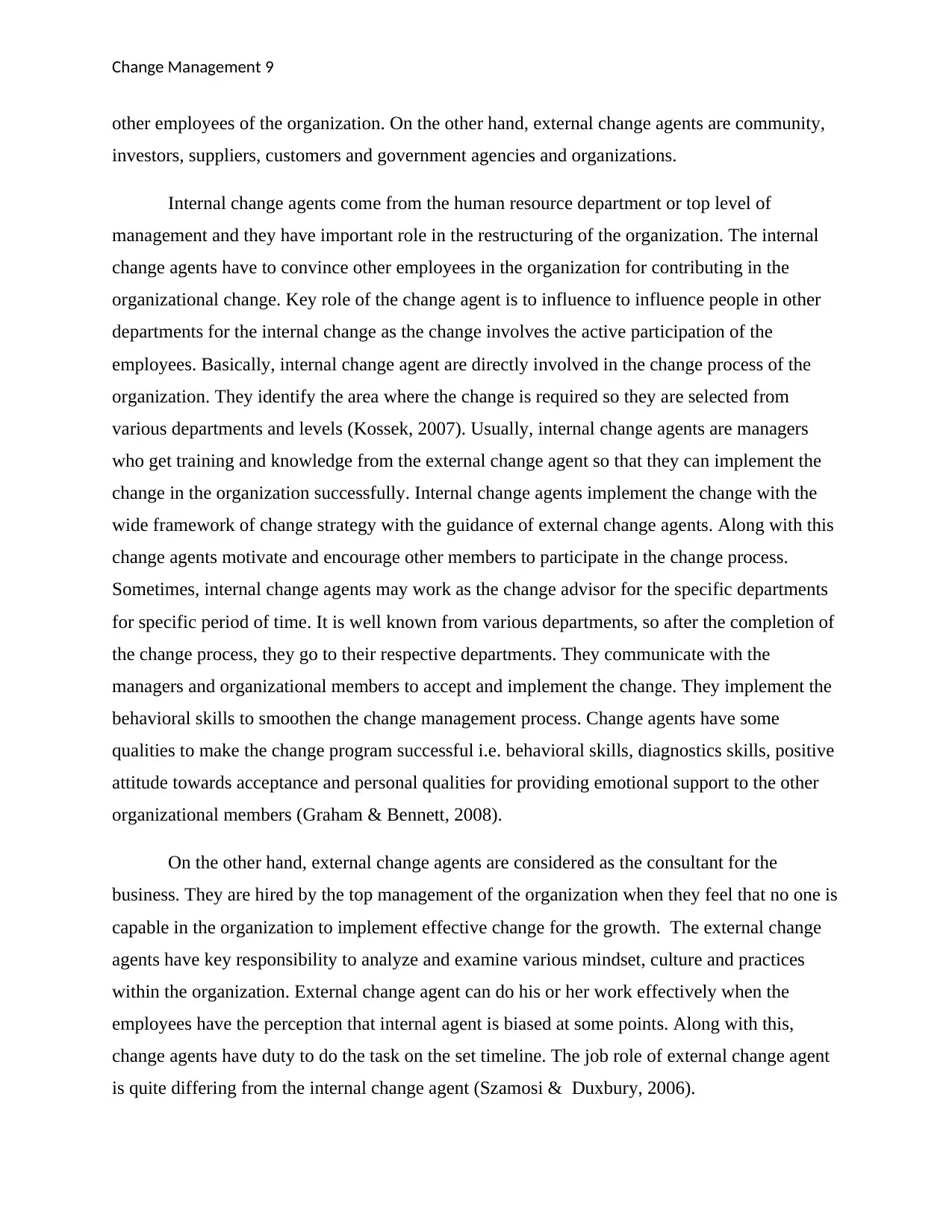
Change Management 9
other employees of the organization. On the other hand, external change agents are community,
investors, suppliers, customers and government agencies and organizations.
Internal change agents come from the human resource department or top level of
management and they have important role in the restructuring of the organization. The internal
change agents have to convince other employees in the organization for contributing in the
organizational change. Key role of the change agent is to influence to influence people in other
departments for the internal change as the change involves the active participation of the
employees. Basically, internal change agent are directly involved in the change process of the
organization. They identify the area where the change is required so they are selected from
various departments and levels (Kossek, 2007). Usually, internal change agents are managers
who get training and knowledge from the external change agent so that they can implement the
change in the organization successfully. Internal change agents implement the change with the
wide framework of change strategy with the guidance of external change agents. Along with this
change agents motivate and encourage other members to participate in the change process.
Sometimes, internal change agents may work as the change advisor for the specific departments
for specific period of time. It is well known from various departments, so after the completion of
the change process, they go to their respective departments. They communicate with the
managers and organizational members to accept and implement the change. They implement the
behavioral skills to smoothen the change management process. Change agents have some
qualities to make the change program successful i.e. behavioral skills, diagnostics skills, positive
attitude towards acceptance and personal qualities for providing emotional support to the other
organizational members (Graham & Bennett, 2008).
On the other hand, external change agents are considered as the consultant for the
business. They are hired by the top management of the organization when they feel that no one is
capable in the organization to implement effective change for the growth. The external change
agents have key responsibility to analyze and examine various mindset, culture and practices
within the organization. External change agent can do his or her work effectively when the
employees have the perception that internal agent is biased at some points. Along with this,
change agents have duty to do the task on the set timeline. The job role of external change agent
is quite differing from the internal change agent (Szamosi & Duxbury, 2006).
other employees of the organization. On the other hand, external change agents are community,
investors, suppliers, customers and government agencies and organizations.
Internal change agents come from the human resource department or top level of
management and they have important role in the restructuring of the organization. The internal
change agents have to convince other employees in the organization for contributing in the
organizational change. Key role of the change agent is to influence to influence people in other
departments for the internal change as the change involves the active participation of the
employees. Basically, internal change agent are directly involved in the change process of the
organization. They identify the area where the change is required so they are selected from
various departments and levels (Kossek, 2007). Usually, internal change agents are managers
who get training and knowledge from the external change agent so that they can implement the
change in the organization successfully. Internal change agents implement the change with the
wide framework of change strategy with the guidance of external change agents. Along with this
change agents motivate and encourage other members to participate in the change process.
Sometimes, internal change agents may work as the change advisor for the specific departments
for specific period of time. It is well known from various departments, so after the completion of
the change process, they go to their respective departments. They communicate with the
managers and organizational members to accept and implement the change. They implement the
behavioral skills to smoothen the change management process. Change agents have some
qualities to make the change program successful i.e. behavioral skills, diagnostics skills, positive
attitude towards acceptance and personal qualities for providing emotional support to the other
organizational members (Graham & Bennett, 2008).
On the other hand, external change agents are considered as the consultant for the
business. They are hired by the top management of the organization when they feel that no one is
capable in the organization to implement effective change for the growth. The external change
agents have key responsibility to analyze and examine various mindset, culture and practices
within the organization. External change agent can do his or her work effectively when the
employees have the perception that internal agent is biased at some points. Along with this,
change agents have duty to do the task on the set timeline. The job role of external change agent
is quite differing from the internal change agent (Szamosi & Duxbury, 2006).
⊘ This is a preview!⊘
Do you want full access?
Subscribe today to unlock all pages.

Trusted by 1+ million students worldwide
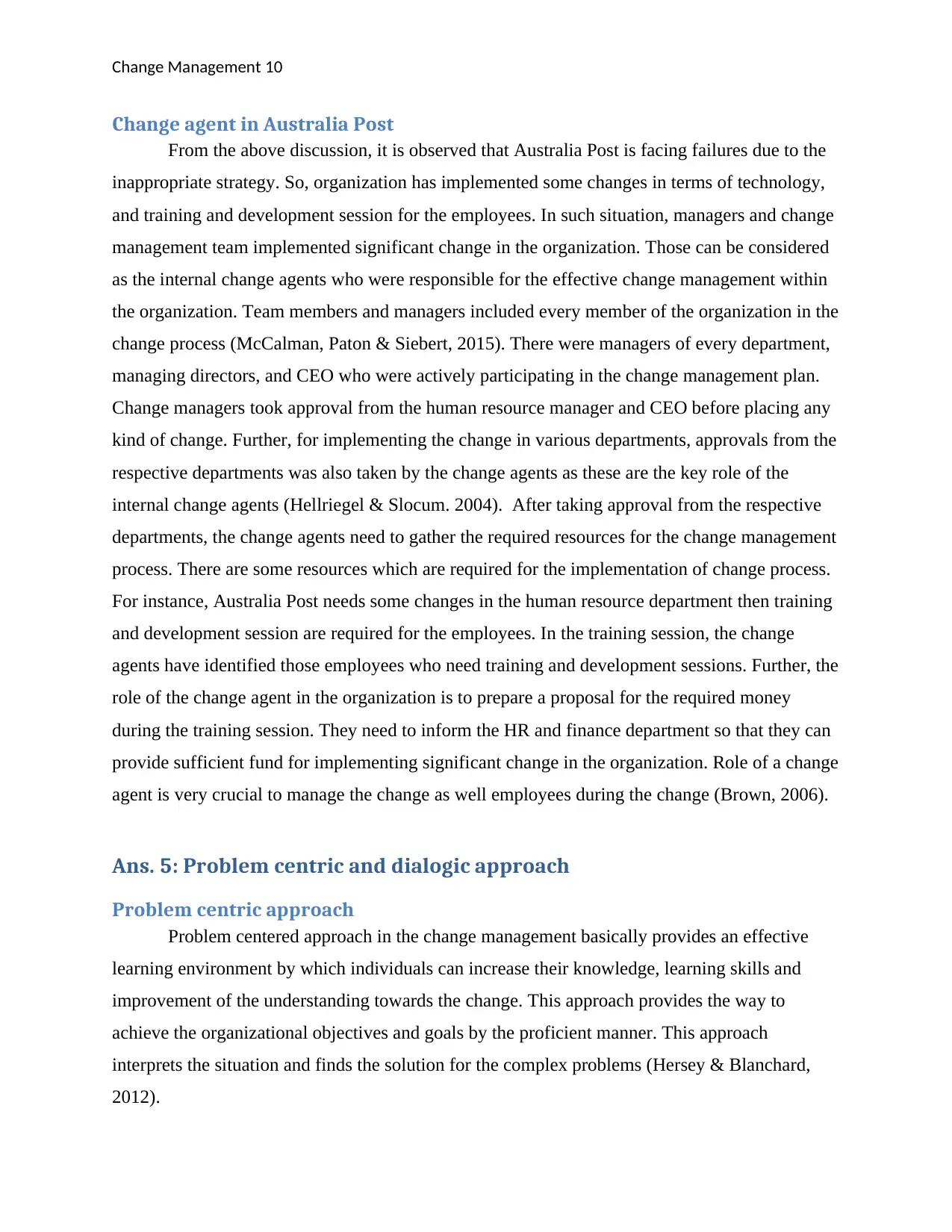
Change Management 10
Change agent in Australia Post
From the above discussion, it is observed that Australia Post is facing failures due to the
inappropriate strategy. So, organization has implemented some changes in terms of technology,
and training and development session for the employees. In such situation, managers and change
management team implemented significant change in the organization. Those can be considered
as the internal change agents who were responsible for the effective change management within
the organization. Team members and managers included every member of the organization in the
change process (McCalman, Paton & Siebert, 2015). There were managers of every department,
managing directors, and CEO who were actively participating in the change management plan.
Change managers took approval from the human resource manager and CEO before placing any
kind of change. Further, for implementing the change in various departments, approvals from the
respective departments was also taken by the change agents as these are the key role of the
internal change agents (Hellriegel & Slocum. 2004). After taking approval from the respective
departments, the change agents need to gather the required resources for the change management
process. There are some resources which are required for the implementation of change process.
For instance, Australia Post needs some changes in the human resource department then training
and development session are required for the employees. In the training session, the change
agents have identified those employees who need training and development sessions. Further, the
role of the change agent in the organization is to prepare a proposal for the required money
during the training session. They need to inform the HR and finance department so that they can
provide sufficient fund for implementing significant change in the organization. Role of a change
agent is very crucial to manage the change as well employees during the change (Brown, 2006).
Ans. 5: Problem centric and dialogic approach
Problem centric approach
Problem centered approach in the change management basically provides an effective
learning environment by which individuals can increase their knowledge, learning skills and
improvement of the understanding towards the change. This approach provides the way to
achieve the organizational objectives and goals by the proficient manner. This approach
interprets the situation and finds the solution for the complex problems (Hersey & Blanchard,
2012).
Change agent in Australia Post
From the above discussion, it is observed that Australia Post is facing failures due to the
inappropriate strategy. So, organization has implemented some changes in terms of technology,
and training and development session for the employees. In such situation, managers and change
management team implemented significant change in the organization. Those can be considered
as the internal change agents who were responsible for the effective change management within
the organization. Team members and managers included every member of the organization in the
change process (McCalman, Paton & Siebert, 2015). There were managers of every department,
managing directors, and CEO who were actively participating in the change management plan.
Change managers took approval from the human resource manager and CEO before placing any
kind of change. Further, for implementing the change in various departments, approvals from the
respective departments was also taken by the change agents as these are the key role of the
internal change agents (Hellriegel & Slocum. 2004). After taking approval from the respective
departments, the change agents need to gather the required resources for the change management
process. There are some resources which are required for the implementation of change process.
For instance, Australia Post needs some changes in the human resource department then training
and development session are required for the employees. In the training session, the change
agents have identified those employees who need training and development sessions. Further, the
role of the change agent in the organization is to prepare a proposal for the required money
during the training session. They need to inform the HR and finance department so that they can
provide sufficient fund for implementing significant change in the organization. Role of a change
agent is very crucial to manage the change as well employees during the change (Brown, 2006).
Ans. 5: Problem centric and dialogic approach
Problem centric approach
Problem centered approach in the change management basically provides an effective
learning environment by which individuals can increase their knowledge, learning skills and
improvement of the understanding towards the change. This approach provides the way to
achieve the organizational objectives and goals by the proficient manner. This approach
interprets the situation and finds the solution for the complex problems (Hersey & Blanchard,
2012).
Paraphrase This Document
Need a fresh take? Get an instant paraphrase of this document with our AI Paraphraser
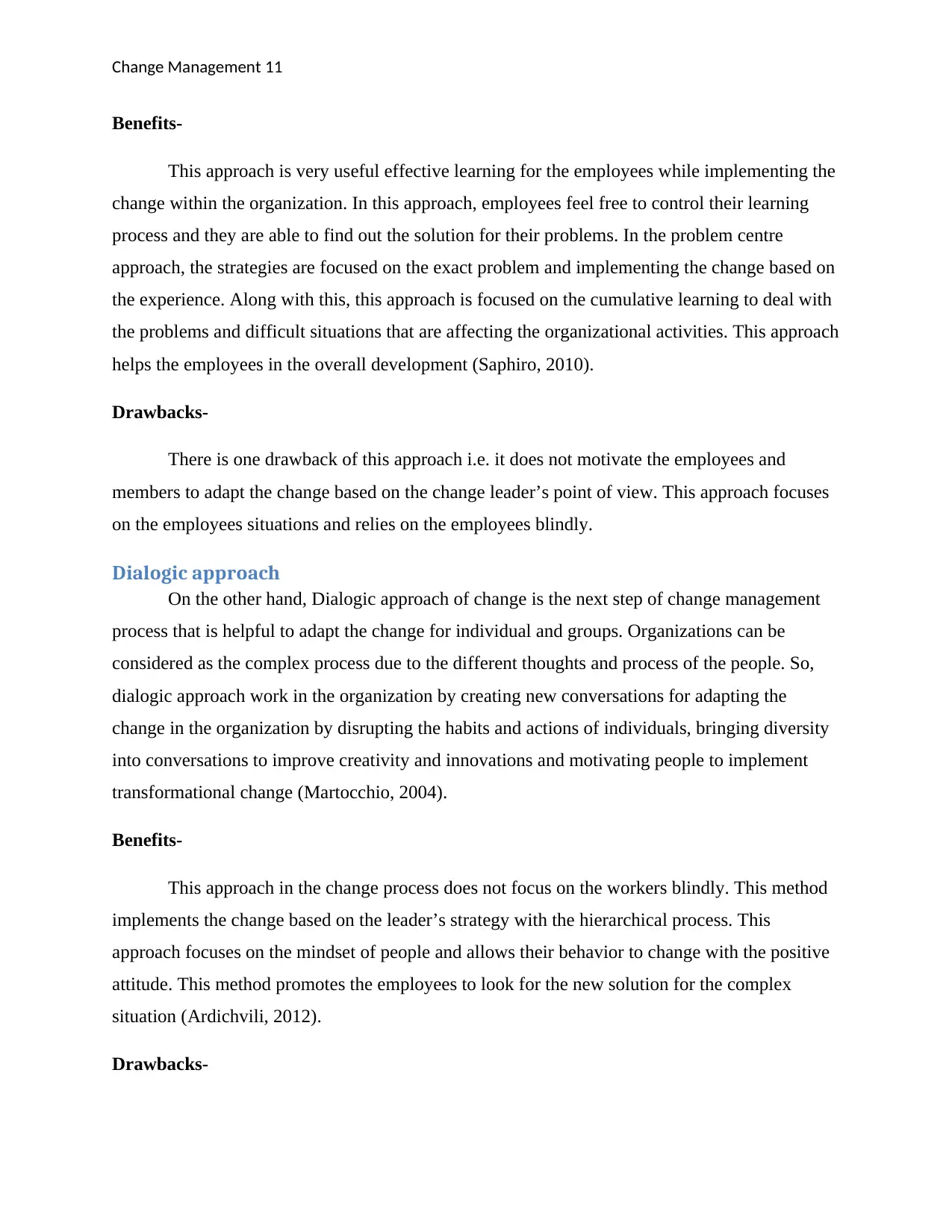
Change Management 11
Benefits-
This approach is very useful effective learning for the employees while implementing the
change within the organization. In this approach, employees feel free to control their learning
process and they are able to find out the solution for their problems. In the problem centre
approach, the strategies are focused on the exact problem and implementing the change based on
the experience. Along with this, this approach is focused on the cumulative learning to deal with
the problems and difficult situations that are affecting the organizational activities. This approach
helps the employees in the overall development (Saphiro, 2010).
Drawbacks-
There is one drawback of this approach i.e. it does not motivate the employees and
members to adapt the change based on the change leader’s point of view. This approach focuses
on the employees situations and relies on the employees blindly.
Dialogic approach
On the other hand, Dialogic approach of change is the next step of change management
process that is helpful to adapt the change for individual and groups. Organizations can be
considered as the complex process due to the different thoughts and process of the people. So,
dialogic approach work in the organization by creating new conversations for adapting the
change in the organization by disrupting the habits and actions of individuals, bringing diversity
into conversations to improve creativity and innovations and motivating people to implement
transformational change (Martocchio, 2004).
Benefits-
This approach in the change process does not focus on the workers blindly. This method
implements the change based on the leader’s strategy with the hierarchical process. This
approach focuses on the mindset of people and allows their behavior to change with the positive
attitude. This method promotes the employees to look for the new solution for the complex
situation (Ardichvili, 2012).
Drawbacks-
Benefits-
This approach is very useful effective learning for the employees while implementing the
change within the organization. In this approach, employees feel free to control their learning
process and they are able to find out the solution for their problems. In the problem centre
approach, the strategies are focused on the exact problem and implementing the change based on
the experience. Along with this, this approach is focused on the cumulative learning to deal with
the problems and difficult situations that are affecting the organizational activities. This approach
helps the employees in the overall development (Saphiro, 2010).
Drawbacks-
There is one drawback of this approach i.e. it does not motivate the employees and
members to adapt the change based on the change leader’s point of view. This approach focuses
on the employees situations and relies on the employees blindly.
Dialogic approach
On the other hand, Dialogic approach of change is the next step of change management
process that is helpful to adapt the change for individual and groups. Organizations can be
considered as the complex process due to the different thoughts and process of the people. So,
dialogic approach work in the organization by creating new conversations for adapting the
change in the organization by disrupting the habits and actions of individuals, bringing diversity
into conversations to improve creativity and innovations and motivating people to implement
transformational change (Martocchio, 2004).
Benefits-
This approach in the change process does not focus on the workers blindly. This method
implements the change based on the leader’s strategy with the hierarchical process. This
approach focuses on the mindset of people and allows their behavior to change with the positive
attitude. This method promotes the employees to look for the new solution for the complex
situation (Ardichvili, 2012).
Drawbacks-
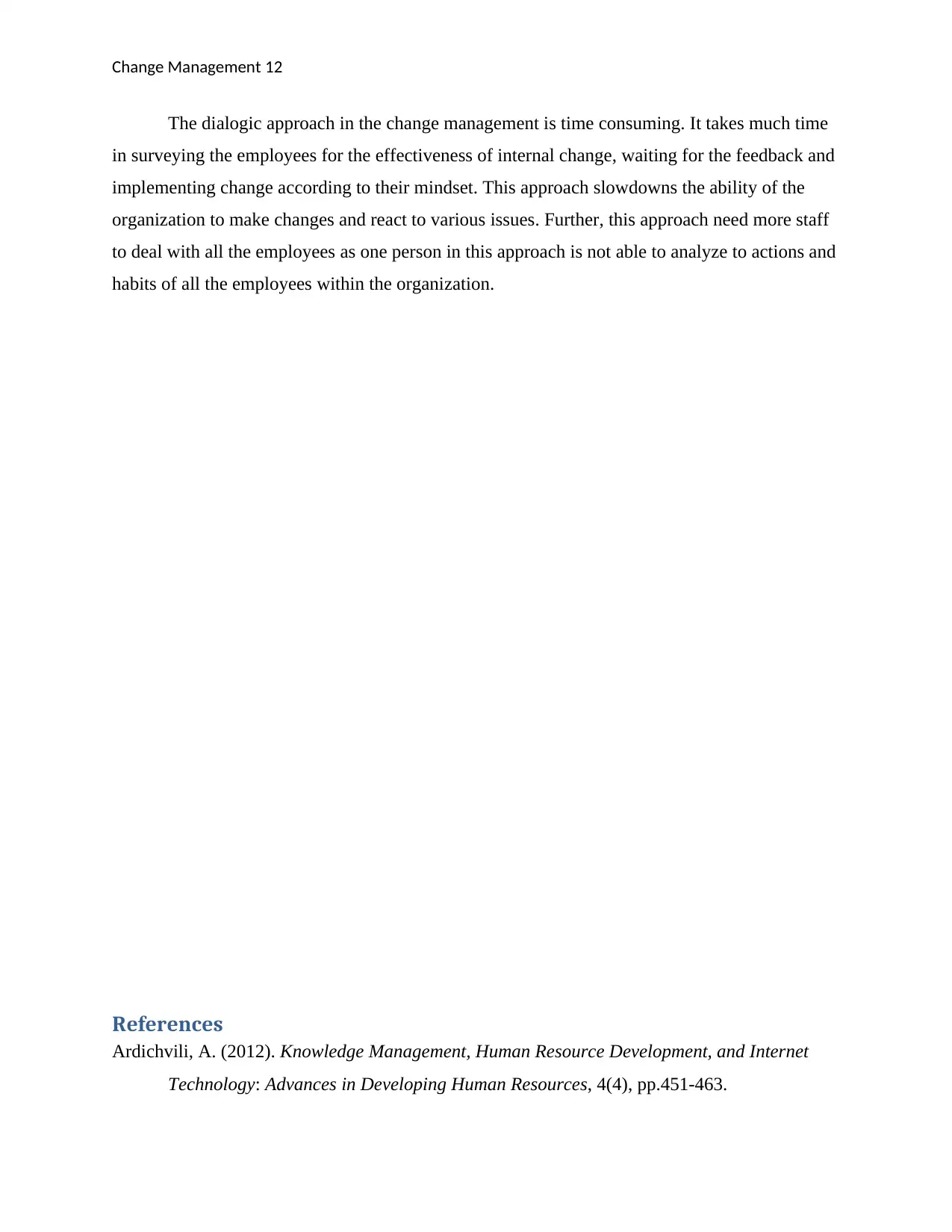
Change Management 12
The dialogic approach in the change management is time consuming. It takes much time
in surveying the employees for the effectiveness of internal change, waiting for the feedback and
implementing change according to their mindset. This approach slowdowns the ability of the
organization to make changes and react to various issues. Further, this approach need more staff
to deal with all the employees as one person in this approach is not able to analyze to actions and
habits of all the employees within the organization.
References
Ardichvili, A. (2012). Knowledge Management, Human Resource Development, and Internet
Technology: Advances in Developing Human Resources, 4(4), pp.451-463.
The dialogic approach in the change management is time consuming. It takes much time
in surveying the employees for the effectiveness of internal change, waiting for the feedback and
implementing change according to their mindset. This approach slowdowns the ability of the
organization to make changes and react to various issues. Further, this approach need more staff
to deal with all the employees as one person in this approach is not able to analyze to actions and
habits of all the employees within the organization.
References
Ardichvili, A. (2012). Knowledge Management, Human Resource Development, and Internet
Technology: Advances in Developing Human Resources, 4(4), pp.451-463.
⊘ This is a preview!⊘
Do you want full access?
Subscribe today to unlock all pages.

Trusted by 1+ million students worldwide
1 out of 14
Related Documents
Your All-in-One AI-Powered Toolkit for Academic Success.
+13062052269
info@desklib.com
Available 24*7 on WhatsApp / Email
![[object Object]](/_next/static/media/star-bottom.7253800d.svg)
Unlock your academic potential
Copyright © 2020–2025 A2Z Services. All Rights Reserved. Developed and managed by ZUCOL.





